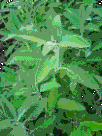Sage
| |
Egyptology Articles
Herbs and Aroma
Alternative
Medicine
Aroma Therapy
|
|
This herb is very common in Egypt as it is present in nature abundantly. It is
used in many culinary and medicinal uses.
Its botanical name is Saliva Officinalis.
Its common name is garden sage, red sage, saurge, Salvia salvatrix. Its Arabic
name is Maryamiah, ( Marameeah, Maramiah, Maryamiya).
It is native to the Mediterranean from thousands of years ago. Ancient
Herbalists used it externally to treat
sprains, swelling, ulcers, and bleeding.
The parts used are
mainly the leaves as whole herbs. Sage is a silvery-green shrub with very
fragrant leaves. The most commonly cultivated species of sage originally came
from the area around the Mediterranean but now also grows in North America. The
leaves of this common kitchen herb are used in medicine as well as in cooking.
Sage generally
grows about a foot or more high, with wiry stems. The leaves are set in pairs on
the stem and are 1 1/2 to 2 inches long, stalked, oblong, rounded at the ends,
finely wrinkled by a strongly-marked network of veins on both sides, greyish-green
in colour, softly hairy and beneath glandular. The flowers are in whorls,
purplish and the corollas lipped. They blossom in August.
The aroma of Sage
can be very powerful with sometimes a bitter taste. All parts of the plant have
a strong, scented odour and a warm, bitter, somewhat astringent taste, due to
the volatile oil contained in the tissues.
|
 |
| |
|
|

|
The main constituent of Sage and its
active principle is a yellow or greenish-yellow volatile oil (sp. gr. 0.910 to
0.930) with a penetrating odour. Tannin and resin are also present in the
leaves, 0.5 to 1.0 per cent of the oil is yielded from the leaves and twigs when
fresh, and about three times this quantity when dry. The volatile oil of sage
contains the constituents alpha- and beta-thujone, camphor, and cineole. It also
contains rosmarinic acid, tannins, and flavonoids
Sage oil contains a
hydrocarbon called Salvene; pinene and cineol are probably present in small
amount, together with vorneol, a small quantity of esters, and the ketone
thujone, the active principle which confers the power of resisting putrefaction
in animal substances. Dextro-camphor is also present in traces. A body has been
isolated by certain chemists called Salviol, which is now known to be identical
with Thujone.
Sage oil of
commerce is obtained from the herb S. officinalis, and distilled to a
considerable extent in Dalmatia and recently in Spain, but from a different
species of Salvia. A certain amount of oil is also distilled in Germany.
The oil distilled in Dalmatia and in Germany is of typically Sage
odour, and is used for flavouring purposes.
Uses
It has many
medicinal and culinary uses.
Medicinal uses
It is an
astringent, antibacterial, aromatic, carminative stimulant and tonic.
Sage makes an
excellent gargle for relaxed throat and tonsils, bleeding gums, laryngitis and
ulcerated throat. In modern European herbal medicine, a gargle of sage tea is
commonly recommended to treat
sore throat,
inflammations in the mouth, and
gingivitis
(inflammation of the gums). Test tube studies have found that sage oil has
antibacterial, antifungal, and antiviral activity which may partially explain
the effectiveness of sage for these indications.
Sage tea is
valuable against delirium of fevers, nervous excitement and accompanying brain
and nervous diseases. It is also used as a stimulant tonic in stomach and
nervous complaints and in weak digestion. It also works as an emmanagogue, in
treating typhoid fever, bilious and liver problems, kidney troubles and lung or
stomach haemorrhage. The infusion is used in head colds, quinsy, measles,
painful joints, lethargy, palsy and nervous headaches.
Fresh leaves are
rubbed on the teeth to cleanse them and strengthen gums, even today sage is
included in toothpastes and tooth powders.
The oil of sage was
used to remove mucus collections from the respiratory organs and is included in
embrocations for rheumatism.
It was also used by herbalists for
rheumatism, excessive menstrual bleeding, and to dry up a mother’s milk when
nursing was stopped. It was particularly noted for strengthening the nervous
system, improving memory, and sharpening the senses.
The herb is also
used and applied warm as a poultice.
Some recent
researches are now done to see the effect of sage in Alzheimer’s disease, as it
is used to improve memory and nervous conditions.
Sage is
also approved in Germany for mild gastrointestinal upset and excessive sweating.
An unpublished, preliminary German study with people suffering from excessive
perspiration found that either a dry leaf extract or an infusion of the leaf
reduced sweating by as much as 50%.
Culinary uses
Sage was used by the Chinese
as a tea, instead of their own traditional tea.
It is also used as a stuffing with onions in ducks and geese.
Dried sage goes well with other assertive herbs, such as rosemary, thyme, and
bay.
It is markedly known for the flavor it provides to Thanksgiving
turkeys, sage
is not only used for stuffing alone. It works well in dishes featuring
cheese,
beans, and
poultry and is
a flavorful addition to herbed
biscuits,
lima beans,
peas,
zucchini, and
cream soups. Chopped fresh, sage is mild enough to add to salads.
Sautéed fresh sage leaves provide an excellent crisp accent for baked
squash and
other winter
vegetables.
Be sure to not overuse sage—just a touch enlivens a dish, whereas too much can
give a bitter effect. Its bold flavor and scent become more powerful when dried.
|
You may freely reprint this article
or place it on your website by
adding this statement: Courtesy of www.kingtutshop.com
|
_________________________________



